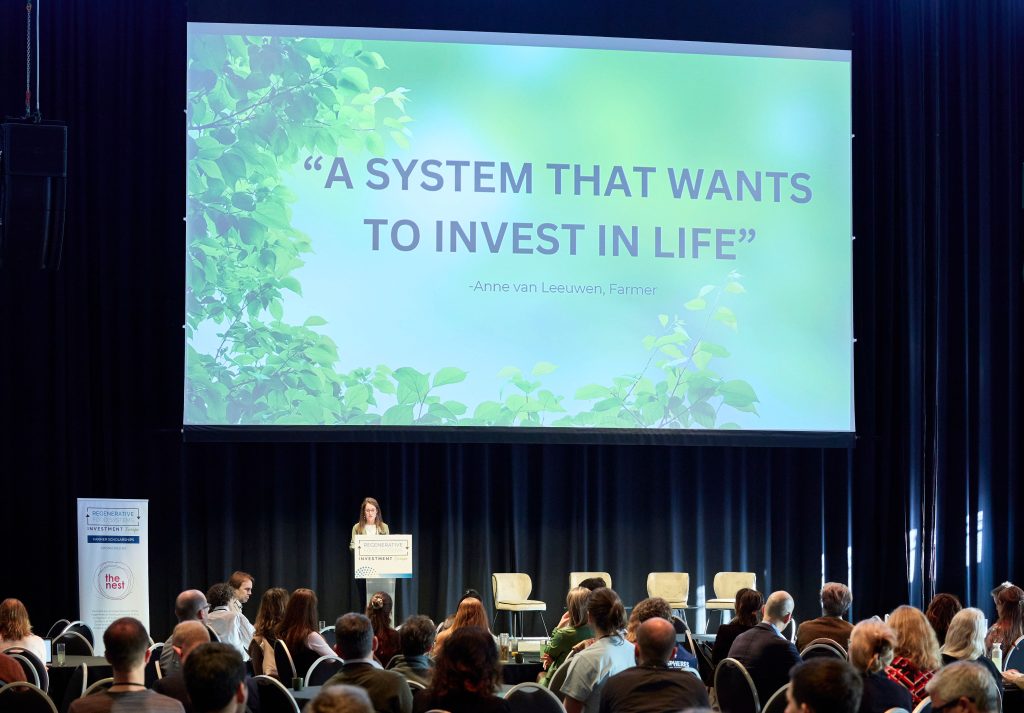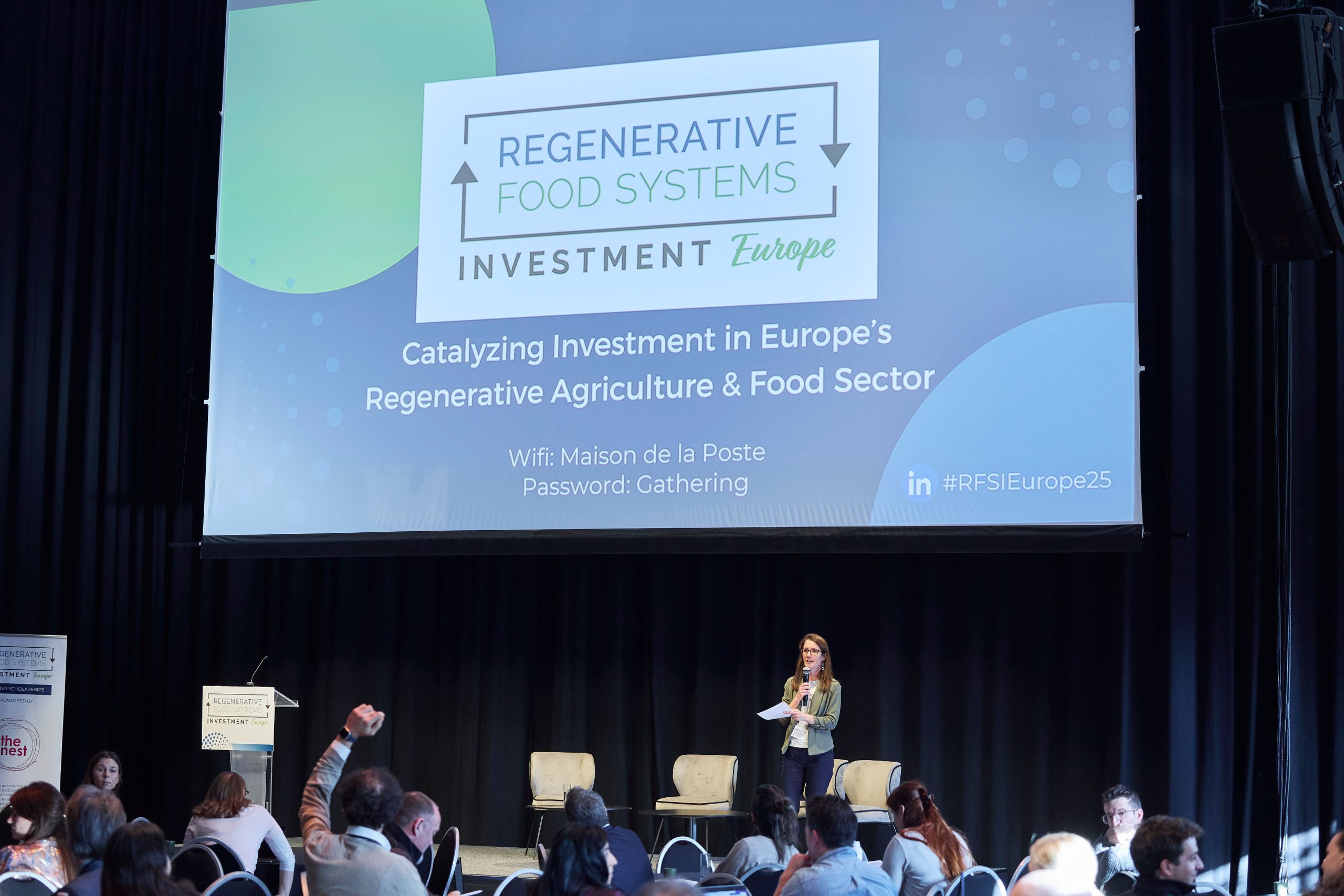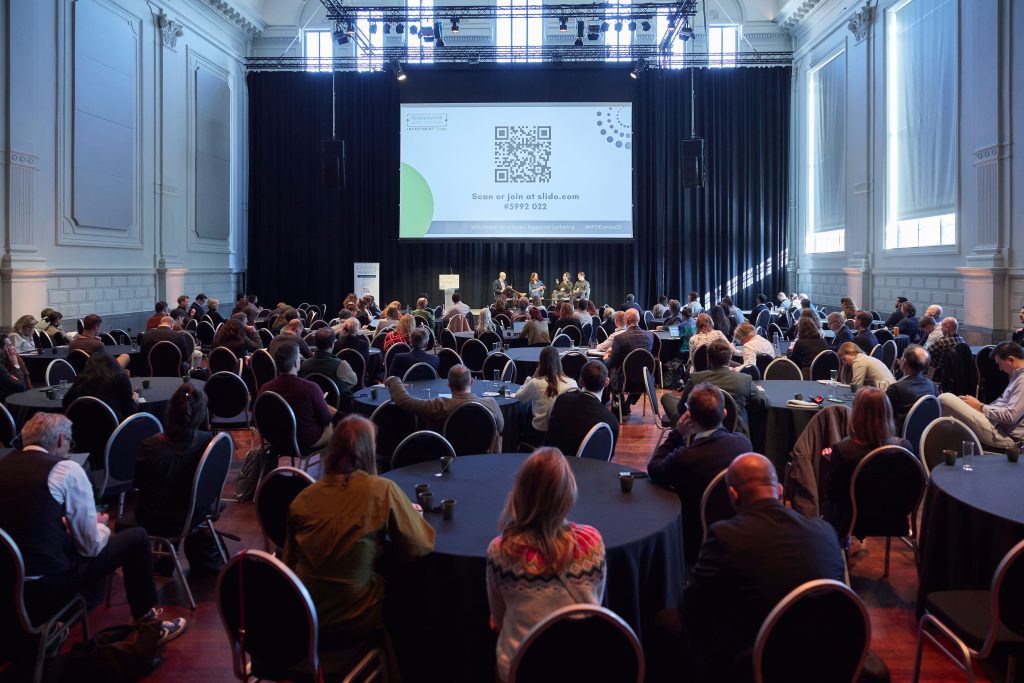Last week, RFSI hosted the 2nd annual RFSI Europe event in Brussels. We started with a moment of reflection.
It had been nearly one year ago, at the first RFSI Europe event in 2024, that Dutch farmer Anne van Leeuwen sat on stage and provided a thought-provoking question:
“How can we create systems that want to INVEST IN LIFE?”
That re-framing of investment in regenerative agriculture and food provided hearty fodder for contemplation throughout the past year.

One conclusion: We – the people who gathered at RFSI Europe last week, the people who gather at the RFSI Forum in the U.S., and others who engage from afar – are the system that wants to invest in life.
This is our work at RFSI: to build the ecosystem of capital that wants to invest in life. By that we mean:
- Invest in healthy living soils and land
- Invest in biodiversity and nature
- Invest nutritious, healthy food that leads to healthy humans
- And invest in our land stewards, laborers, and supply chain workers– so that they may thrive.
This is RFSI’s work, not only because it’s the right thing to do, but also because it makes good business and investment sense. We believe investing in life will lead to not only tremendous impact outcomes – but notable financial outcomes, as well.
But Anne’s question can also provide a useful framing for all work across the space.
Regeneration is Here
Today, more than two months in to 2025, we are at what appears to be a crucial point in the transformation of agriculture and food systems. The momentum for regeneration is distinct – we felt it in spades at last week’s RFSI Europe 2025 event and it emanates far beyond those that were there with us. How can we tell?
There’s an increasing number of farmers pioneering the transition on the farm and increasing acreage. We can also see it in the incredible growth of organizations like EARA — the European Alliance for Regenerative Agriculture – designed to give rise to the voices of farmers in transition.
Governments and public policy makers are acknowledging the very real risk presented by climate change and degradation of nature, including that caused by extractive agricultural practices. We are increasingly seeing policies and public sector investment that seeks to address these risks and support transition. For example, The Climate Risk Disclosure Act in the U.S., the European Climate Law, the Nature Restoration Law, and even as recently as two weeks ago, the European Commission’s Vision for Agriculture & Food acknowledged the need for climate resilience and that farmers are one of the best lines of defense for this.
Businesses and asset owners are starting to see and feel the importance of investing in nature and climate positive land use – seeing how critical investments in natural capital will de-risk production and create resilience in business models and investment outcomes. As an example: in 2024, RFSI tracked 45 commitments to regenerative targets and pilots by multinational agriculture and food companies. Also in 2024, research commissioned by Gresham House shows that 50% of UK asset owners are either already investing in natural capital or will do so within the next 18 months, and that 73% of UK asset owners would invest in natural capital to support climate adaptation.
Another indicator: Systemic coordination to enable the movement of capital toward the building of regenerative supply chains and landscapes is coming together through organizations like Transformational Investing in Food Systems (TIFS), OP2B, EIT, TransCap Initiative, Climate Farmers and many more.
All of these industry players are finding themselves drawn to regenerative for seemingly different reasons. But the truth is, it all boils down to three things: risk mitigation, impact, and economic opportunity. Regeneration drives all three of these. And as the many diverse stakeholders get behind this movement, the opportunity that exists for regenerative agriculture is only further reinforced, serving as a much-welcomed tailwind.
Urgency and Opportunity
We can’t, however, take this momentum for granted or become complacent. While regeneration may call for patient capital, we must act with urgency.
There continue to be forces working against this momentum…
- Climate continues to drive disruption: extreme weather events cause catastrophe for many – industry and individuals – as the recent LA fires remind us.
- The complexities of transitioning both on and off the farm – and the challenges that brings – still hinder adoption across the value chain.
- Ambiguity in the space and the nascency of much of the work leaves room for doubters and late adopters to remain inactive on the sideline.
- Politics – in the U.S. and around the world – is causing chaos and uncertainty for those working on the ground toward solutions and is threatening to undo progress toward formalized systems and structures that support our ability to invest in life.
While these headwinds can sometimes feel relentless and unforgiving and while they bring unwanted chaos, they too, bring opportunity.
The opportunities include:
1: To make the case for systems transformation stronger and louder! The headwinds described above offer even greater reason for investment in systems change. Investments in regeneration build resilience – resilience in our soils, on our farms, in our supply chains, in our bodies, in our businesses and in our investments. The business, financial, environmental and social risk of doing nothing – or not enough – far outweighs the risks of being audacious in our efforts for change.
2: To move this work forward with urgency and intention – because unlike so many other fields of work that one could spend one’s time in, regeneration can actually work to address the polycrises of environmental degradation, climate change, biodiversity and nature loss, human health decline, and dwindling social welfare.
3: To align one’s approach to investment and systems-building with nature. Let me explain by returning to Anne’s vision of systems that want to invest in life.


Nature is one of the most powerful representations of life. At the same time, to embrace nature is to embrace resilience. Why? Because nature is the ultimate example of resilience. Nature is full of complexity, but its complexity and diversity are one of its greatest strengths. It contributes to nature’s ability to be adaptive and to evolve in the face of disaster or threat. It is this adaptation and cooperation, coordination, and collaboration within the natural ecosystem that make nature both awe-inspiring and capable of so much more than would be possible otherwise.
Reflection for the Journey Ahead
As we embarked on two days of in-depth learning and connection at last week’s RFSI Europe event, we invited the community to reflect: how can your investments and your work in this space support life and embrace these characteristics of nature: complexity, adaptability, and cooperation, so that you, too, can achieve so much more than you thought possible.
What we discovered was inspiring and tangible progress in the space, growing opportunity… and more questions. Stay tuned as we share key take aways next week!
Sarah Day Levesque is Managing Director at RFSI. This article is adapted from opening comments she presented at the 2025 RFSI Europe event.
